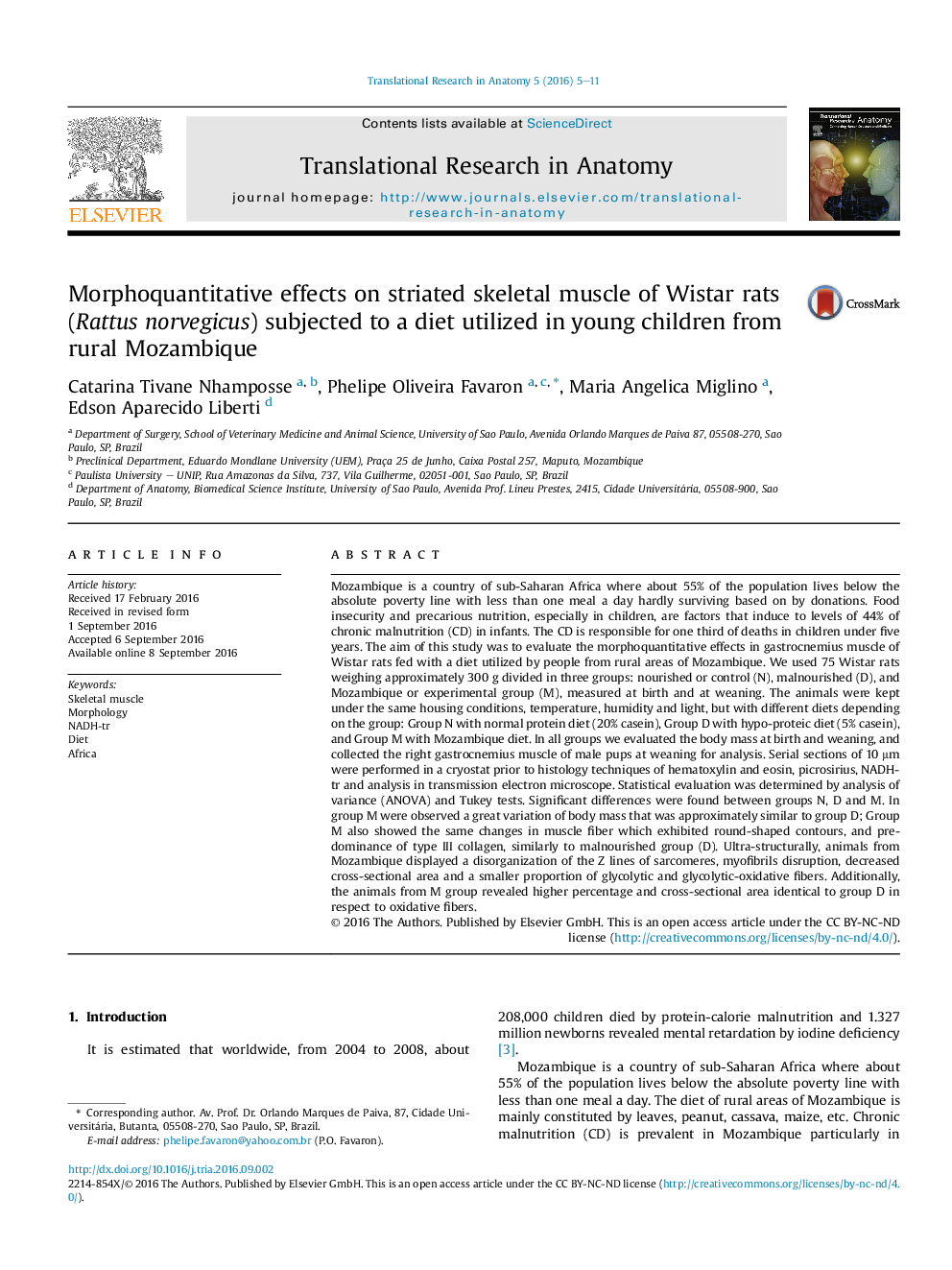| Article ID | Journal | Published Year | Pages | File Type |
|---|---|---|---|---|
| 6090663 | Translational Research in Anatomy | 2016 | 7 Pages |
â¢Mozambique is a country where about 55% of the population lives below the absolute poverty line with less than one meal a day.â¢Chronic malnutrition is responsible for one third of deaths in children under five years.â¢Three Groups: nourished or control (N), malnourished (D), and Mozambique or experimental group (M), were studied and received different diets.â¢In group M was observed a great variation of body mass that was approximately similar to group D; Group M showed the same changes in muscle fiber which exhibited round-shaped contours, and predominance of type III collagen.â¢Mozambique samples showed a disorganization of the Z lines of sarcomeres and myofibrils disruption, decreased cross-sectional area and a smaller proportion of glycolytic and glycolytic-oxidative fibers, and higher percentage and cross-sectional area identical to group D with respect to oxidative fibers.â¢Structurally, the gastrocnemius muscle of animals with protein deprivation and those who received the standard diet of Mozambique, made several changes that can perhaps be applied to other skeletal musculature.
Mozambique is a country of sub-Saharan Africa where about 55% of the population lives below the absolute poverty line with less than one meal a day hardly surviving based on by donations. Food insecurity and precarious nutrition, especially in children, are factors that induce to levels of 44% of chronic malnutrition (CD) in infants. The CD is responsible for one third of deaths in children under five years. The aim of this study was to evaluate the morphoquantitative effects in gastrocnemius muscle of Wistar rats fed with a diet utilized by people from rural areas of Mozambique. We used 75 Wistar rats weighing approximately 300 g divided in three groups: nourished or control (N), malnourished (D), and Mozambique or experimental group (M), measured at birth and at weaning. The animals were kept under the same housing conditions, temperature, humidity and light, but with different diets depending on the group: Group N with normal protein diet (20% casein), Group D with hypo-proteic diet (5% casein), and Group M with Mozambique diet. In all groups we evaluated the body mass at birth and weaning, and collected the right gastrocnemius muscle of male pups at weaning for analysis. Serial sections of 10 μm were performed in a cryostat prior to histology techniques of hematoxylin and eosin, picrosirius, NADH-tr and analysis in transmission electron microscope. Statistical evaluation was determined by analysis of variance (ANOVA) and Tukey tests. Significant differences were found between groups N, D and M. In group M were observed a great variation of body mass that was approximately similar to group D; Group M also showed the same changes in muscle fiber which exhibited round-shaped contours, and predominance of type III collagen, similarly to malnourished group (D). Ultra-structurally, animals from Mozambique displayed a disorganization of the Z lines of sarcomeres, myofibrils disruption, decreased cross-sectional area and a smaller proportion of glycolytic and glycolytic-oxidative fibers. Additionally, the animals from M group revealed higher percentage and cross-sectional area identical to group D in respect to oxidative fibers.
